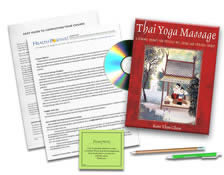An increasing number of massage therapists are adding the use of essential oils into their bodywork sessions. Because of the ease of incorporation into a treatment, enthusiastic client appreciation and increased therapeutic benefits are all responsible for the increased inclusion of therapeutic essential oils into a bodyworker’s repertoire.
Whether using lavender to enhance relaxation, juniper to relieve arthritis pain or clary sage to ease depression, adding a few drops of a high quality essential oil to a carrier oil can add an entirely new dimension to somatic healing therapies. Aromatherapy is rooted in science, and intensive study of this field unveils its layers of complexity in botany, neurobiology and organic chemistry. While essential oils can be purchased anywhere and used by anyone interested, the use of high quality, 100 percent pure and unadulterated essential oils is recommended after acquiring in-depth, working knowledge of their therapeutic uses. The following tips will help those therapists with a basic foundational introduction to maintain essential oil safety and outcome optimization:
Do’s
- Dilute – Always dilute an essential oil in a carrier oil prior to application. The vast majority of essential oils are too concentrated to apply directly to the skin, and some can cause serious irritation, such as cinnamon bark. However, dabbing lavender or tea tree oil directly on certain spots qualify as common exceptions. Examples of carrier oils are sweet almond, jojoba, apricot kernel, borage and grapeseed. A general rule of thumb is to mix 8-10 drops of an essential oil with one ounce of carrier oil.
- Storage – Store essential oils in dark glass bottles, either amber or cobalt, in a cool, dark location. While high quality essential oils do not turn rancid, exposure to light, humidity, air and heat can break down the oil, reducing its therapeutic value. Keep them tightly capped. Most essential oils can remain at optimal potency for up to two years if kept chilled although, as a general rule, the citrus essential oils have a short shelf life and the florals the longest. In addition, essential oils are highly flammable, so keep them stored away from flames or other combustibles.
- Test – Since the limbic brain anchors past experiences with associated aromas, and personal preferences vary, allow each client to take a whiff of an oil to determine his or her affinity for it. A negative emotional reaction to a smell will hinder any possible therapeutic benefits. In addition, by placing a drop of diluted essential oil on the skin, conduct a patch test for individuals with skin sensitivity. While this requires a 24-hour waiting period, you can determine if a client has sensitivity to the oil you wish to use during the following session.
- Specific health concerns – For specific health concerns, consult an aromatherapy text, seek the advice of a certified aromatherapist, or take a NAHA-approved educational course, such as the Institute’s Aromatherapy Essentials for the Massage Therapist. Conditions such as epilepsy, asthma and high blood pressure warrant specific training in the safe use of essential oils. While some oils may exacerbate these conditions, others may provide substantial benefits. Research extensively and continue to study aromatherapy to learn as much as you can before addressing specific health concerns.
Don’ts
- Pregnancy – Safety is key. Do not use certain essential oils topically on a pregnant woman. Several sources conclude that the following oils may be harmful during pregnancy and should be avoided in any form whether topical, diffused, or in hydrotherapy: bitter almond, basil, cedarwood, cinnamon, rosemary, peppermint, rose, sage, thyme, wintergreen, clary sage, cypress, hyssop, clove bud, marjoram, myrrh, juniper, geranium and fennel. If using any essential oils during pregnancy, first assess safety.
- Mucous membranes – Because they are potent and can be highly irritating, do not allow any essential oils to make contact with eyes or other mucous membranes and wash hands after handling. This includes refraining from rubbing one’s eyes or touching genitalia with any essential oil residue on the hands. Be aware the undiluted essential oils can damage the surface of furniture so clean up spills promptly. Rubbing alcohol can be an effective aid for such clean ups.
- Ingestion – Do not ingest essential oils. Many are toxic when taken internally, and an attempt to ingest essential oils should only commence under the direct advice and care of a highly competent, experienced, certified aromatherapist with medical training.
- Sun exposure – Some oils, especially in the citrus family, can render the skin photosensitive and cause pigmentation. Do not apply to uncovered areas prior to sun exposure, especially if there is a history of melanoma. Oils known to have this effect include bergamot, lime, cumin, mandarin, lemon, tangerine, orange, verbena, angelica, caraway, cassia, cinnamon bark, grapefruit, honeysuckle, laurel leaf, patchouli, cedarwood and dill weed.
The above tips serve as a guide to help a novice safely experiment with essential oil use. To fully incorporate aromatherapy into your practice, a comprehensive NAHA (National Association for Holistic Aromatherapy) approved course such as is highly recommended. After mastering these basic safety aspects of aromatherapy, you’ll appreciate the simplicity of including therapeutic oils into a massage session. Clients love the smell and additional dimension of healing experienced with aromatherapy. The advantages of essential oil massage is steadily catching on in the bodywork community, heightening the demand for educated, skilled aromatherapy practitioners.
















